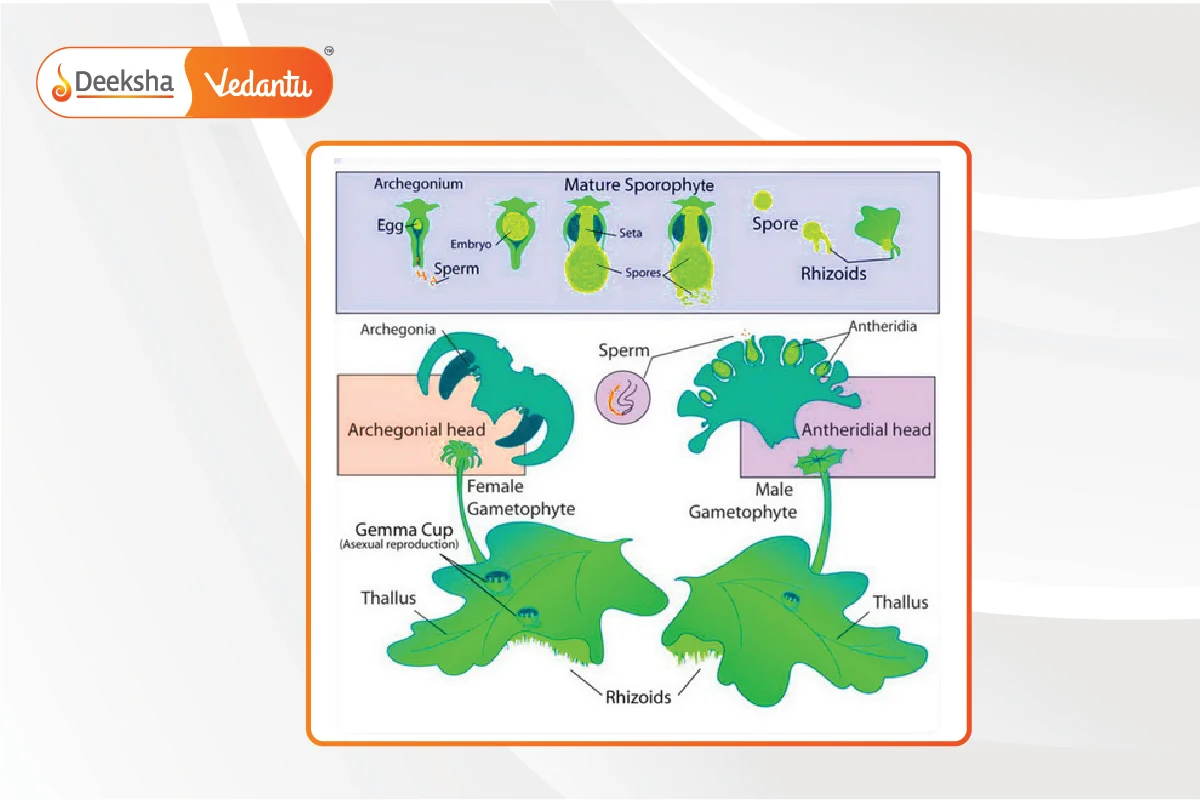Marchantia is a genus of liverworts classified under bryophytes, commonly found in moist and shady environments. They lack true roots, stems, and leaves, instead featuring a thalloid plant body. Bryophytes are known as the amphibians of the plant kingdom due to their requirement for water to complete their life cycle and reproduce sexually.
Classification of Marchantia
Marchantia falls under the division Hepaticophyta, which encompasses all liverworts. Other classifications within Bryophyta include:
- Hepaticopsida: Liverworts
- Anthocerotopsida: Hornworts
- Bryopsida: Mosses
Taxonomic Hierarchy:
- Kingdom: Plantae
- Division: Hepaticophyta
- Class: Hepaticopsida
- Order: Marchantiales
- Family: Marchantiaceae
- Genus: Marchantia
Characteristics of Marchantia
- Habitat: Found in moist, shady places.
- Plant Body: Thalloid, dorsiventral, flat, and dichotomously branched. The dominant phase is the haploid gametophyte.
- Dorsal Surface: Contains diamond-shaped markings with central pores for gas exchange.
- Ventral Surface: Contains scales and rhizoids, which are unicellular and root-like, aiding in anchoring and absorption.
- Reproductive Structures: Present on the dorsal surface, featuring gemmae cups for asexual reproduction and specialized stalks (antheridiophore and archegoniophore) for sexual reproduction.
- Epidermis: Upper epidermis has air pores leading to air chambers in the photosynthetic zone. The storage zone beneath lacks chloroplasts and stores nutrients.
- Rhizoids and Scales: Extend from the lower epidermis for support and absorption.
Reproduction in Marchantia
Asexual Reproduction
- Gemmae: Multicellular, green asexual buds formed in gemma cups located on the dorsal surface. They detach and germinate to form new plants.
Sexual Reproduction
- Dioecious Nature: Separate male and female plants.
- Male Organ (Antheridia): Produces biflagellate antherozoids from androcytes.
- Female Organ (Archegonia): Flask-shaped, containing neck canal cells, a ventral canal cell, and an egg.
Fertilization:
- Requires water for antherozoids to swim towards and fertilize the egg.
- Formation of a diploid zygote.
Sporophyte
- Development: The zygote develops into a sporophyte, which is differentiated into foot, seta, and capsule.
- Dependency: Sporophyte is dependent on the gametophyte for nourishment.
- Spore Production: Spore mother cells undergo meiosis to produce haploid spores, which germinate under favorable conditions to form new gametophytes.
Life Cycle of Marchantia

- Alternation of Generations: Haploid gametophyte alternates with the diploid sporophyte.
- Gametophyte: The dominant, free-living stage.
- Sporophyte: Short-lived, dependent on the gametophyte.
Key Phases:
- Gametophyte: Produces antherozoids and eggs.
- Fertilization: Fusion of antherozoid and egg to form a diploid zygote.
- Sporophyte: Zygote develops into sporophyte; produces spores through meiosis.
- Spore Germination: Spores germinate to form new gametophytes.
FAQs
Marchantia exhibits a haplodiplontic life cycle, alternating between a dominant haploid gametophyte and a short-lived diploid sporophyte.
Rhizoids anchor the plant to the substratum and absorb water and minerals.
The male antheridia and female archegonia, located on antheridiophore and archegoniophore stalks, respectively.
Through gemmae, which are multicellular buds formed in gemma cups on the gametophyte’s dorsal surface.
Marchantia thrives in moist and shady environments.
Related Topics
- Connective Tissue
- Nostoc
- Protozoa
- Important Notes For NEET Biology – Cell Cycle and Cell Division
- Epithelial Tissue
- Important Notes For NEET Biology – The Living World
- Paramecium
- Important Notes For NEET Biology -Shapes of Bacteria
- Important Notes For NEET Biology – Chromosome Structure
- Bryophytes
- Difference between Ideal Solution and Non-ideal Solution
- What is Hemoglobin
- Plasmid
- DNA Polymerases
- Important Notes For NEET Biology – Breathing and Exchange of Gases





Get Social